Types of transistors (Beginners Guide, 2025)
Transistors are used to amplify and switch electronic signals and electrical power in various applications. Various types of transistors are available for different applications.
The main two types of transistors are Bipolar junction transistors (BJTs) and Field effect transistors (FETs). Other types include Insulated-gate bipolar junction transistors, power transistors, phototransistors, uni-junction, heterojunction, Darlington, Schottky, and avalanche transistors.
This article will provide a detailed overview of the various types of transistors, their characteristics, and their applications.
Types of transistors
Transistors are typically made from semiconductor materials, such as silicon or germanium. They have three layers: the emitter, base, and collector.
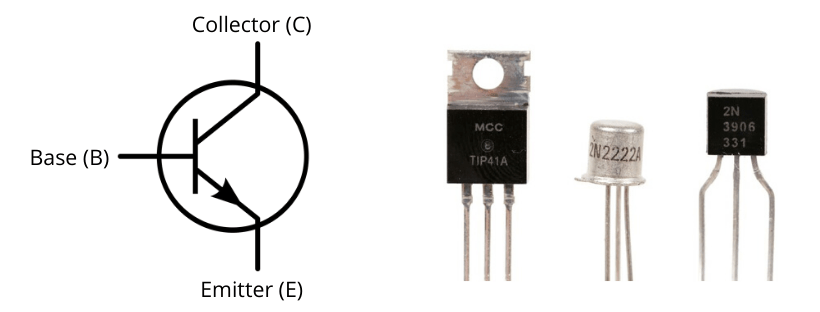
The transistor works by controlling the flow of current between two of its terminals based on the current or voltage applied to the third terminal.
If you want to learn more about transistors check out our article:
The most common type of transistor is the bipolar junction transistor (BJT), which has two types: NPN (negative-positive-negative) and PNP (positive-negative-positive).
Another type of transistor is the field-effect transistor (FET), which includes the junction field-effect transistor (JFET) and the metal-oxide-semiconductor field-effect transistor (MOSFET).
There are also some other types of transistors used in various electronic applications.
Bipolar junction transistors (BJTs)
The first one of the main types of transistors is Bipolar junction transistors shortly called BJTs. The term bipolar means that both electrons and holes are required for current conduction.
It consists of three regions: the emitter, base, and collector. The emitter is heavily doped, while the base is lightly doped and sandwiched between the emitter and collector, which are oppositely doped.
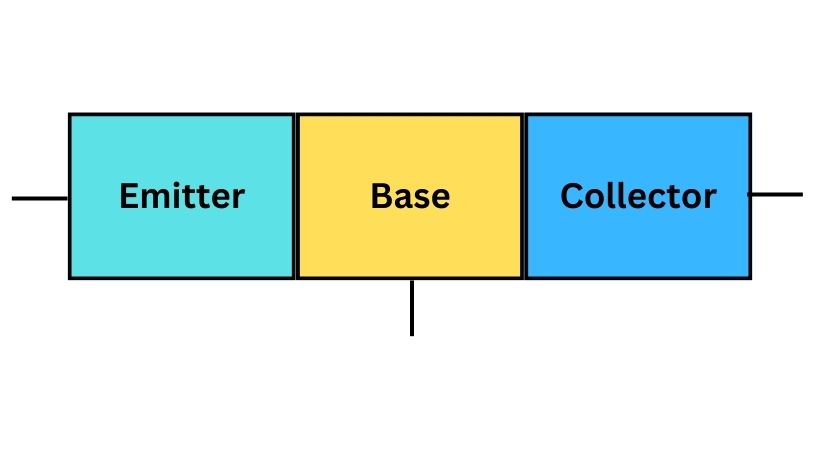
The function of BJTs upon the control flow of current between the emitter and collector by the base current. We can also say that they are essentially current-controlling devices.
When a small current flows into the base-emitter junction, it controls a much larger current flowing between the collector and emitter. This amplification property makes BJTs useful for amplifying weak signals.
There are two types of BJT transistors: NPN and PNP.
NPN Transistors
An NPN transistor is a type of bipolar junction transistor (BJT) that consists of three layers of semiconductor material: an N-doped emitter, a P-doped base, and an N-doped collector.

It is one of the most commonly used transistors in electronic circuits. In this type of transistor, the electrons are the majority carriers and holes are the minority carriers.
Due to the electrons as majority carriers, this type is used in a wide range of applications as the electrons have high speed as compared to the holes.
When a small current, known as the base current (Ib), is applied to the base, it enables the transistor to control a much larger current, known as the collector current (Ic), flowing from the collector to the emitter.
The base current acts as a control signal, regulating the flow of electrons from the emitter to the base.
PNP Transistors
A PNP transistor is a type of bipolar junction transistor (BJT) consisting of three semiconductor material layers: a P-doped emitter, an N-doped base, and a P-doped collector.
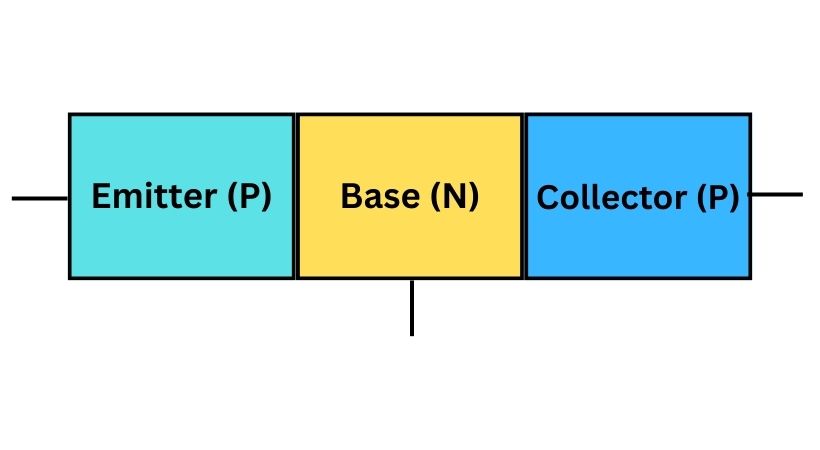
It is a counterpart to the NPN transistor, with the majority of charge carriers being holes instead of electrons.
In the PNP, the emitter is heavily doped with P-type material, creating an excess of holes.
The base, which is lightly doped with N-type material, acts as a thin barrier between the emitter and collector regions.
The collector is moderately doped with P-type material and is larger compared to the other layers.
The circuit symbols of NPN and PNP transistors are given below.
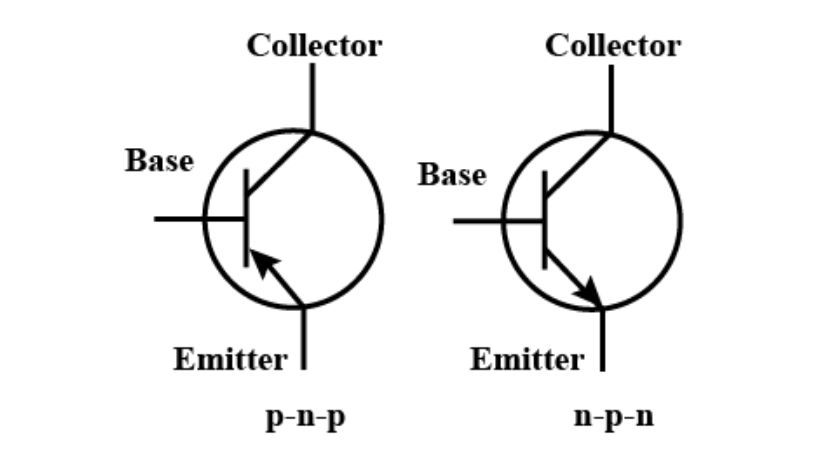
Bipolar junction transistors (BJTs) have a wide range of applications in electronic circuits due to their ability to amplify signals and control current flow. Here are some common applications of BJT transistors:
- Amplification
- Switching
- Oscillators
- Logic circuits
- Temperature sensors
- Converters
These are just a few examples of the many applications of BJT transistors.
Field effect transistors (FETs)
Field effect transistors are another major type of transistor and in the literature, it is also called FETs. The operation of FETs is based on the modulation of an electric field within a semiconductor channel.
FETs have three terminals: the source, the drain, and the gate. The gate terminal controls the flow of current between the source and drain terminals.
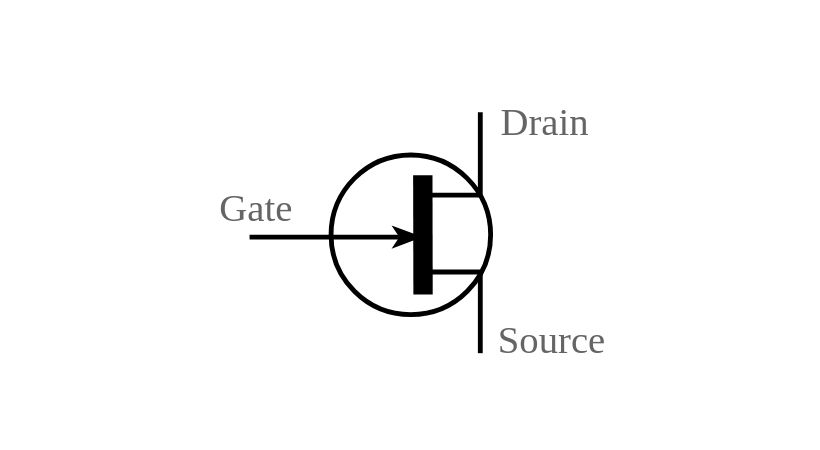
FETs come in different variations, including the Metal-Oxide-Semiconductor Field-Effect Transistor (MOSFET) and the Junction Field-Effect Transistor (JFET).
Metal-Oxide-Semiconductor Field-Effect Transistor (MOSFET)
The MOSFET is the most widely used type of FET.
It consists of a semiconductor channel, typically made of silicon, with a metal gate electrode separated from the channel by a thin insulating layer, usually made of silicon dioxide (SiO2).

It also has two subtypes: the n-channel MOSFET (NMOS) and the p-channel MOSFET (PMOS). The types of MOSFET depend upon the majority of charge carriers in the channel.
The NMOS has an n-type channel. When a voltage is applied to the gate terminal, the electric field created by the gate voltage attracts electrons from the n-type channel, forming an electron channel between the source and drain.
The PMOS has a p-type channel. When a voltage is applied to the gate terminal, the electric field repels holes in the p-type channel, creating a hole channel between the source and drain.
Here are the circuit symbols of PMOS and NMOS.

Junction field effect transistor
Another kind of FET is a Junction field effect transistor or JFET. It is one of the simplest types of FETs.
JFET is a voltage-control device and no biasing current is needed for it. The source, drain, and gate are the three parts of JFET.
The transistor’s source and drain current are controlled by the voltage that is applied between the gate and the source.
There are two kinds of JFETs with a single channel: the n-channel JFET (NJFET) and the p-channel JFET (PJFET), which vary based on the kind of major charge carriers in the channel.
In NJFET the current flows due to the electrons and the voltage is applied between the source and gate. The channel is found between the drain and source and is called n-channel.
The NJFETs are used in most of the applications due to the flow of electrons.
The current is due to the flow of holes in the PJFET. The channels found in these transistors are called p-channels. The symbol of PJFET and NJFET are given below.
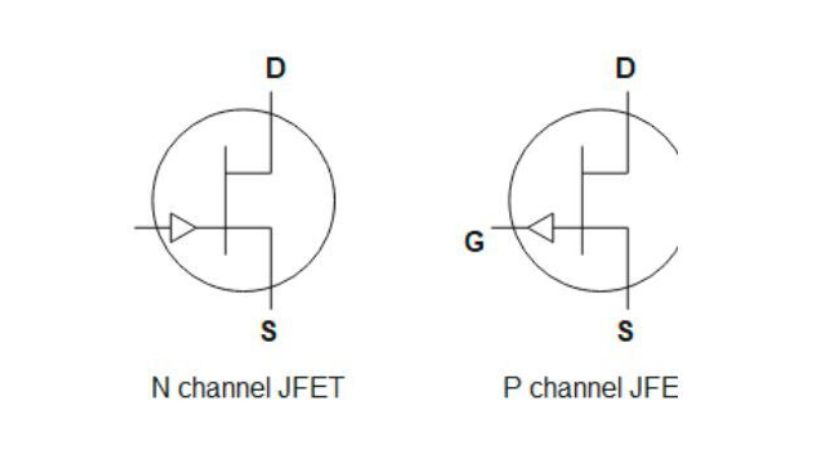
Field-effect transistors (FETs) find numerous applications across various electronic devices and circuits due to their unique characteristics. Here is a list of common applications of FETs:
- Amplifiers
- Switches
- Oscillators
- Mixers and Modulators
- Microwave devices
- Integrated Circuits
There are many more applications of FETs which makes them versatile devices.
Difference between BJTs and FETs
Here are some notable differences between bipolar junction transistors and field effect transistors.
| BJTs | FETs |
| BJT has three semiconductor layers – emitter, base, and collector. There are two types: NPN (Negative-Positive-Negative) and PNP (Positive-Negative-Positive). | FET has three terminals – gate, source, and drain. There are two main types: N-channel (N-MOSFET) and P-channel (P-MOSFET). |
| Current-controlled devices. The small current flowing into the base controls a much larger current flowing between the collector and emitter. | Voltage-controlled devices. The voltage applied to the gate controls the current flow between the source and drain. |
| Generally have lower input impedance compared to FETs. | Generally have higher input impedance, making them suitable for high-impedance input applications. |
| Generally have slower switching speeds compared to FETs. | Tend to have faster switching speeds, making them suitable for high-frequency applications. |
Understanding these differences is crucial when selecting transistors for specific applications, as the choice between BJTs and FETs depends on factors such as the required voltage, current, frequency, and power characteristics of the circuit.
Other types of transistors
Some other types of transistors are designed for specific applications. Let’s discuss these in detail.
Power transistors
Power transistors are a category of transistors designed to handle higher power levels and currents. These transistors are found in NPN, PNP, and darlinton transistors.
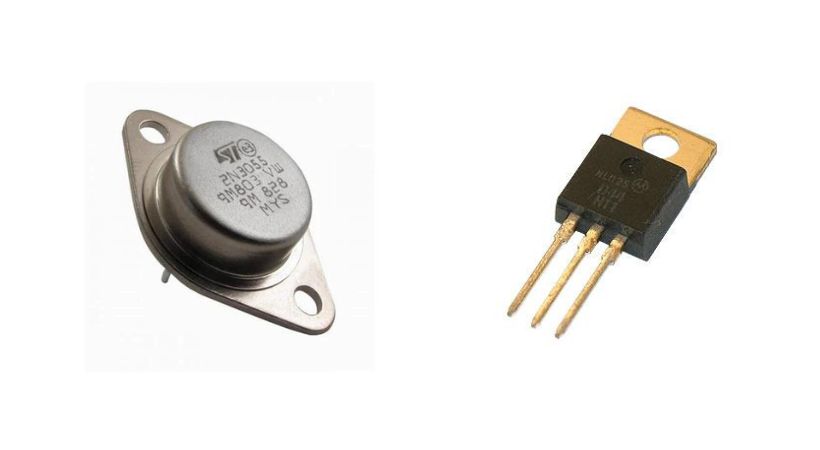
They offer high collector current, operating frequency, and power handling ranges. The collector current for these transistors is from 1 to 100A, the frequency ranges from 1 to 100 MHz and power is from 10 to 300W.
Here we listed some of the applications of transistors.
- Power amplification
- Switching
- High-frequency applications
- Motor control
- Power supplies
- Power inverted
These transistors are used in applications where handling of high voltage, current, and power is required.
Uni-junction transistors
The Unijunction Transistor (UJT) is a three-terminal semiconductor device that exhibits unique characteristics and is primarily used in relaxation oscillator circuits.
It is a type of thyristor, which is a four-layered, three-junction semiconductor device.
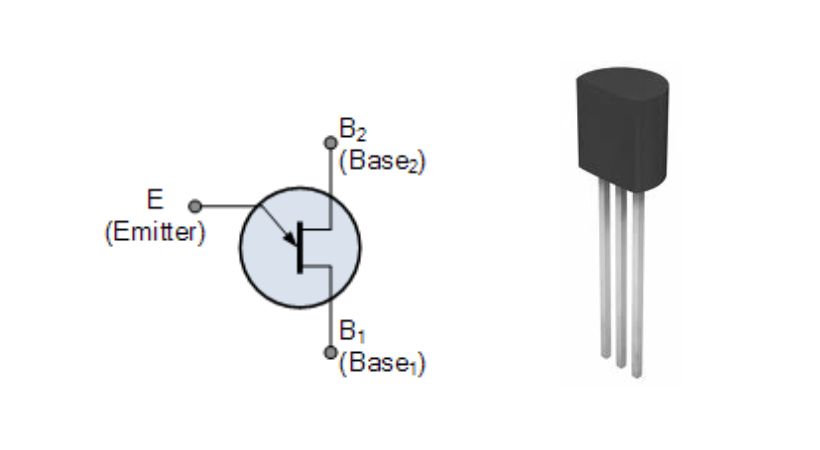
This type of transistor has three terminals, the two are called base terminals and the third one is the emitter terminal.
When no voltage is applied to the emitter terminal and also to the base terminals, a small base current will flow between B1 and B2.
If the right amount of voltage is applied across the emitter terminal, a current will start flowing which will combine with the base current as a result a very high current will flow in the transistor.
These transistors are not suitable for amplification purposes because the base current is very small.
The UJT’s unique characteristics make it suitable for specific applications, notably in relaxation oscillator circuits.
It is commonly used as a timing device in applications such as
- Oscillators
- Pulse generators
- Sawtooth waveform generators
- Timing circuits
- Trigger generators
- Light dimmers
While Unijunction Transistors might not be as versatile as some other transistor types, their unique characteristics make them valuable in specific applications where relaxation oscillators and timing circuits are required.
Phototransistors
One kind of transistor made especially to react to light and change it into an electrical signal is called a phototransistor.
Combining the characteristics of a bipolar transistor and a photodiode, it is a light-sensitive device.

The phototransistor responds to light by producing a current or voltage that can be amplified and utilized in a variety of ways.
When light strikes the light-sensitive region of the phototransistor, it generates electron-hole pairs within the semiconductor material.
These electron-hole pairs enhance the conductivity of the region, allowing current to flow between the collector and emitter terminals. The amount of current or voltage generated depends on the intensity of the incident light.
Phototransistors find numerous applications in various fields, including:
- Smoke detectors
- Laser-ranging finding devices
- Optical remote controls
- Fiber optics transmission lines
- Automotive applications
Phototransistors are light-sensitive devices that offer high sensitivity, amplification capabilities, and fast response times.
Hetero-junction transistors
The Heterojunction Transistor, also known as the Heterojunction Bipolar Transistor (HBT), is a type of transistor that combines different semiconductor materials with varying bandgaps to enhance its performance characteristics.
It is the improved version of BJT as it can handle high-frequency signals, up to several hundred GHz.
The Heterojunction Transistor consists of multiple layers of different semiconductor materials, each with its own specific bandgap. The operation of the hetero-junction transistors is the same as the BJT transistors.
Here is a list of some applications in which this type of transistor is used.
- Radiofrequency
- Digital and analog microwave
- Radar system
- High-speed digital circuits
- High-frequency amplifications
The use of different semiconductor materials in the emitter and collector regions of hetero-junction transistors allows for enhanced efficiency and speed.
Darlington transistors
Two bipolar transistors coupled together to increase current are called a Darlington transistor, sometimes referred to as a Darlington pair.

It bears the name Sidney Darlington in honor of its creator. Applications requiring great amplification and switching capabilities frequently use the Darlington transistor, which has a high current gain.
Two bipolar transistors linked in a certain way make up a Darlington transistor. The first transistor’s emitter is linked to the second transistor’s base. Both transistors’ collector terminals are linked together.
The input is represented by the base terminal of the first transistor, while the output is represented by the collector terminal of the second transistor.
Applications for Darlington transistors in electronic circuits include the following:
- Power amplifications
- Switching circuits
- Current sensing
- Display driver
- Motor controllers
- Touch and light sensors
- Solenoid control
- Audio amplification output stages
Darlington transistors offer significant advantages in terms of current gain and application versatility, it’s essential to consider their higher voltage drop and power dissipation.
Schottky transistors
A Schottky diode is a type of semiconductor diode characterized by rapid switching and a low forward voltage drop.
It is created when a metal layer and a semiconductor material—typically silicon—join together.
Schottky diodes have quicker switching speeds because their metal-semiconductor junction differs from a typical diode’s conventional P-N junction in some ways.
The Schottky transistors are used in various electronic devices. Here are some applications where Schottky transistors are utilized.
- High-speed digital Logic Gates
- Digital Integrated Circuits
- Clock and Timing Circuits
- RF Applications
- Power Supply Switching
It’s essential to note that the specific applications of Schottky transistors can vary based on the integrated circuit design and the requirements of the electronic system.
High-frequency transistors
High-frequency transistors, also known as RF (Radio Frequency) transistors, are specialized transistors designed to operate efficiently at high frequencies typically in the radio frequency range.
They are specifically engineered to handle high-frequency signals with minimal distortion and loss.
Applications of High-frequency Transistors
High-frequency transistors find applications in a wide range of areas. Following are some of the applications of high-frequency transistors.
- Wireless Communication Systems
- Radar Systems
- Satellite Communication
- High-Frequency Amplifiers
- Television and Broadcasting
Above mentioned are the applications of high-frequency transistors.
Conclusion
In conclusion, transistors play a vital role in the world of electronics, serving as essential components in various circuits.
Different types of transistors are available in the market with various applications. The main two types of transistors are
- Bipolar junction transistors (BJTs)
- Field effect transistors (FETs)
There are also some other types of transistors that are designed for different applications. The other types of transistors include:
- Power transistors
- Phototransistors
- Uni-junction transistors
- Hetero-junction transistors
- Darlington transistors
- Schottky transistors
- High-frequency transistors
Learning the advantages and uses of each transistor is the secret to creating effective and customized electrical systems that power gadgets that have become essential to our daily lives.
I hope you will enjoy this detailed article about types of transistors.
Thank you and stay blessed…
Other useful posts:
